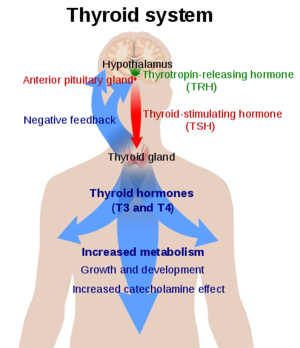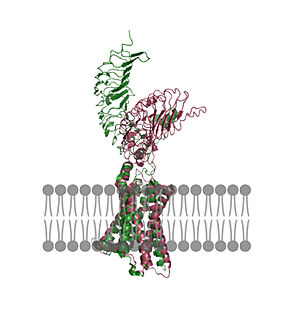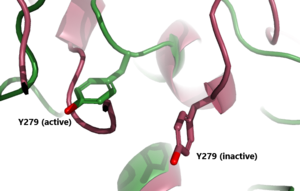Sandbox Reserved 1792
From Proteopedia
(Difference between revisions)
| Line 12: | Line 12: | ||
TSHR has 3 main domains</scene>: Leucine Rich Region Domain (coral), the hinge region (blue-purple), and the transmembrane region(rainbow). The leucine rich region domain is the extracellular TSH ligand domain. The hinge connects the Leucine Rich Repeat Domain and the Transmembrane Region. It provides flexibility for the switch between the active and inactive state of TSHR. The transmembrane region is located within the plasma membrane. Its function transmit the extracellular signal across the membrane to the intracellular [https://en.wikipedia.org/wiki/G_protein G-proteins] bound to the N-terminus of the transmembrane region<ref name="Duan"/>. Activated G-proteins then signal a robust intracellular signaling cascade. | TSHR has 3 main domains</scene>: Leucine Rich Region Domain (coral), the hinge region (blue-purple), and the transmembrane region(rainbow). The leucine rich region domain is the extracellular TSH ligand domain. The hinge connects the Leucine Rich Repeat Domain and the Transmembrane Region. It provides flexibility for the switch between the active and inactive state of TSHR. The transmembrane region is located within the plasma membrane. Its function transmit the extracellular signal across the membrane to the intracellular [https://en.wikipedia.org/wiki/G_protein G-proteins] bound to the N-terminus of the transmembrane region<ref name="Duan"/>. Activated G-proteins then signal a robust intracellular signaling cascade. | ||
=== Transmembrane Region=== | === Transmembrane Region=== | ||
| - | <scene name='95/952720/Transmembrane_region_spin/5'>The Transmembrane Region</scene> (<scene name='95/952720/Transmembrane_region_top-view/2'>top-view</scene>) is embedded within the cell membrane, like other G-protein receptors, it is composed of a 7-pass helix <ref name="Faust" | + | <scene name='95/952720/Transmembrane_region_spin/5'>The Transmembrane Region</scene> (<scene name='95/952720/Transmembrane_region_top-view/2'>top-view</scene>) is embedded within the cell membrane, like other G-protein receptors, it is composed of a 7-pass helix <ref name="Faust"> DOI:10.1038/s41586-022-05159-1</ref>. The transmembrane region is surrounded by a "belt" of <scene name='95/952720/Tmd_cholesterol_spin/2'>15 cholesterols</scene><ref name = "Duan"> DOI 10.1038/s41586-022-05173-3</ref>. When cholesterol binding sites are mutated, TSHR activity decreases. These cholesterols are likely important for TSHR function <ref name="Duan"/>. Additionally, at the N-terminus, the transmembrane region binds to the <scene name='95/952720/Transmembrane_g-protein/1'>G-protein</scene>, which are located intracellularly <ref name="GOEL"/>. The G-proteins are made up of three subunits: α,β, and γ. When TSHR is activated, it causes the Gα subunit to dissociate from the Gβγ subunits. The Gα subunit is responsible for activating [https://en.wikipedia.org/wiki/Adenylyl_cyclase adenylyl cyclase], [https://en.wikipedia.org/wiki/Phospholipase_C phospholipase C] and [https://en.wikipedia.org/wiki/Ion_channel ion channels]. This sets off the robust intracellular signaling cascade<ref name="GOEL"> PMID:24255551</ref>. |
Revision as of 17:58, 20 April 2023
Thyroid Stimulating Hormone Receptor (TSHR)
| |||||||||||
References
- ↑ Hanson, R. M., Prilusky, J., Renjian, Z., Nakane, T. and Sussman, J. L. (2013), JSmol and the Next-Generation Web-Based Representation of 3D Molecular Structure as Applied to Proteopedia. Isr. J. Chem., 53:207-216. doi:http://dx.doi.org/10.1002/ijch.201300024
- ↑ Herraez A. Biomolecules in the computer: Jmol to the rescue. Biochem Mol Biol Educ. 2006 Jul;34(4):255-61. doi: 10.1002/bmb.2006.494034042644. PMID:21638687 doi:10.1002/bmb.2006.494034042644
- ↑ 3.0 3.1 3.2 3.3 3.4 Duan J, Xu P, Luan X, Ji Y, He X, Song N, Yuan Q, Jin Y, Cheng X, Jiang H, Zheng J, Zhang S, Jiang Y, Xu HE. Hormone- and antibody-mediated activation of the thyrotropin receptor. Nature. 2022 Aug 8. pii: 10.1038/s41586-022-05173-3. doi:, 10.1038/s41586-022-05173-3. PMID:35940204 doi:http://dx.doi.org/10.1038/s41586-022-05173-3
- ↑ 4.0 4.1 4.2 Faust B, Billesbolle CB, Suomivuori CM, Singh I, Zhang K, Hoppe N, Pinto AFM, Diedrich JK, Muftuoglu Y, Szkudlinski MW, Saghatelian A, Dror RO, Cheng Y, Manglik A. Autoantibody mimicry of hormone action at the thyrotropin receptor. Nature. 2022 Aug 8. pii: 10.1038/s41586-022-05159-1. doi:, 10.1038/s41586-022-05159-1. PMID:35940205 doi:http://dx.doi.org/10.1038/s41586-022-05159-1
- ↑ 5.0 5.1 Goel R, Raju R, Maharudraiah J, Sameer Kumar GS, Ghosh K, Kumar A, Lakshmi TP, Sharma J, Sharma R, Balakrishnan L, Pan A, Kandasamy K, Christopher R, Krishna V, Mohan SS, Harsha HC, Mathur PP, Pandey A, Keshava Prasad TS. A Signaling Network of Thyroid-Stimulating Hormone. J Proteomics Bioinform. 2011 Oct 29;4:10.4172/jpb.1000195. PMID:24255551 doi:10.4172/jpb.1000195
- ↑ Chen CR, McLachlan SM, Rapoport B. Thyrotropin (TSH) receptor residue E251 in the extracellular leucine-rich repeat domain is critical for linking TSH binding to receptor activation. Endocrinology. 2010 Apr;151(4):1940-7. doi: 10.1210/en.2009-1430. Epub 2010 Feb 24. PMID: 20181794; PMCID: PMC2851189. [DOI 10.1210/en.2009-1430 https://www.ncbi.nlm.nih.gov/pmc/articles/PMC2851189/]
Student Contributors
- Alex Kem
- Grace Lane



